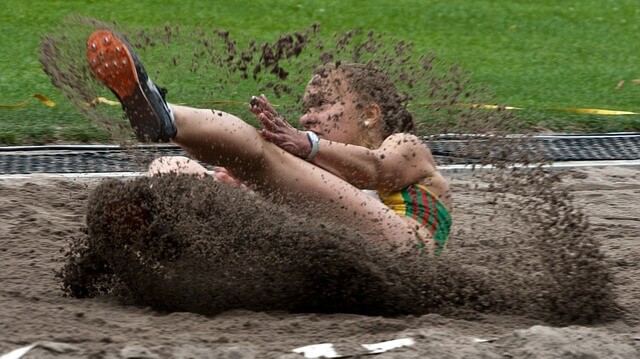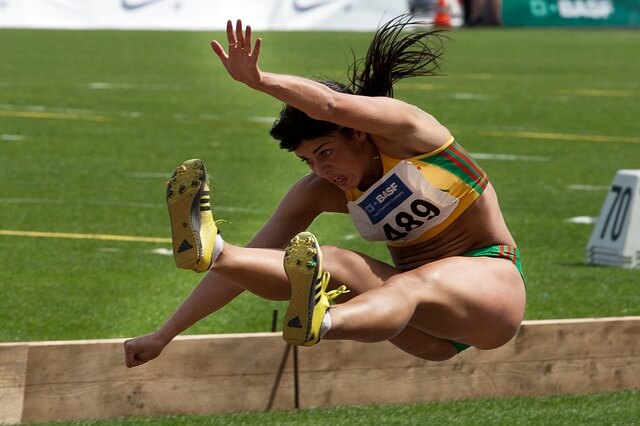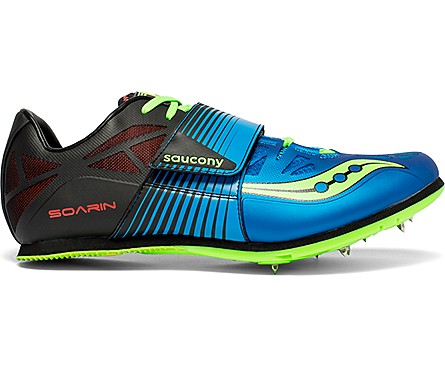How to Find the Best Long Jump Spikes
Why You Need Long Jump Spikes
Every time you line up to begin your approach, there are plenty of thoughts racing through your mind. Your heart starts racing and the nerves start kicking in. You might get nervous about slipping on the block, or tripping on the approach. However, the reality is that long jump spikes alleviate these worries because of their technology.
Despite all of this, I still see several athletes refuse to purchase spikes for long jump because they think they just don’t need it. By not using long jump spikes, you are putting yourself at risk for injury and limiting yourself.
One of the most common questions we get is do long jump spikes make a difference. We answer the following everytime: Absolutely! The spikes located at the balls of your feet for sturdy grip and the built-in stiff sole to help the metatarsophalangeal joints absorb energy.
During the take-off phase, the metatarsophalangeal joints absorb about 60-100 J of the horizontal energy. However, the stiff sole returns that energy back to the athlete. This technology alone provides an additional 5-10 centimeter jump increase.
If you also do other track & field events like triple jump, check out our post on “The Ultimate Guide to Track Spikes for Every Single Event” for our top picks.
Benefits of Long Jump Spikes
There are numerous reasons to invest into a pair of long jump spikes. They simplify the biomechanics of long jump. They help put you into proper positions to executive all phases of a proper jump. Overall, there are four major phases in the long jump technique: the approach, last two strides, takeoff and landing.
- Approach Phase: Firstly, these spikes are built to ensure that maximum horizontal speed is acheived prior to your final two stides and take off.
- Last Two Strides: Secondly, they give you the ability to center your mass to set yourself up correctly for takeoff.
- Takeoff & Action In The Air: Most importantly, the takeoff will be easier to acheive because of a built-in stiff sole. This will help you transfer the generated horizontal energy into vertical energy. It allows a strong flat foot at the board to get maximum bounce on your takeoff.
- Landing: Lastly, these spikes will help the you absorb all of the energy when landing. They’ll help you prevent injuries and keep you from falling back.
In conclusion, getting a pair of new spikes for long jump can be a complete game changer. Every single phase of your jump will improve. Be sure to check out our #1 recommended best long jump spikes in the “Our Recommended Best Sprint Spikes for Jumping” section below.

Long Jump vs. Sprint Spikes
One of the most common questions we get is: what’s the difference between long jump and sprint spikes?
People often wonder if they can use sprint spikes to long jump. The simple answer is yes. However, using sprint spikes significantly increases your chances for injury. The difference between long jump and sprint spikes is the stiff sole on the heel. The most important phase of any jump is the takeoff. Your foot must be flat during takeoff. Sprint spikes do not provide enough support on the heel as they were built to keep the athlete on the balls of their feet. If you’re using sprint spikes to long jump, you’re actually putting yourself at a severe disadvantage.

Despite knowing this, there are several long jumpers that swear by using sprint spikes for jumping purposes. For this reason, we will provide our top recommendations for long jump and sprinting spikes.
Using Long Jump Spikes for Sprinting Purposes
Alternatively, people want to know if they can use long jump spikes for sprinting purposes. Our response: why? While it is important to save money, it’s also arguably more important to do what is right for your body. If you’re jumping, you should be using spikes specifically for jumping because it was designed to have a stiffer heel and have a more stable fit than sprint spikes. If you’re a sprinter, you should be using spikes specifically for sprinting because they will be lighter and have a more aggressive feel to it.
The only exception to this rule is for throwing events. Shot put, discus and hammer throw utilize the same technology in their shoes, but in different ways. If you want to learn more about the throwing shoes that we recommend, please visit our “The Best 3 Throwing Shoes for Shot Put, Discus & Hammer” post.
In conclusion, Everyone has their own preference. Therefore, it is important for us to provide our recommendations for both long jump and sprinting spikes for jumping purposes.
Our Recommendation: Saucony Sourin’ J 2’s

Our #1 recommended spikes for long jump are the Saucony Sourin’ J 2’s. These shoes will absolutely be a game changer in your next season, and will help you compete at another level. Saucony has always been at the top of their game with track spikes, but they reached another level with the Saucony Sourin’ J 2’s.
Technology
Your approach will become faster with the Saucony Sourin’ J2’s. The tested and proven Saucony Sourin’ J2’s will help you elevate to new levels this season. These track spikes allow for a snug fit with a wide, midfoot strap to secure it all in.
It comes equipped with FLEXIFILM technology, Saucony’s branded lightweight material, providing a flexible feel. Additionally, it comes packed with ISOFIT material, which provides a comfortable and stable feel. It’s sole is stiff and will allow you to finesse a strong takeoff foot every time.
We’d highly recommend the Saucony Sourin’ J 2’s for long jumpers at any level. They are incredibly versatile and built for high performance. These spikes are our #1 suggestion for any long jumper this upcoming season.
Best Sprint Spikes for Jumping
We have to keep things real with you: if you’re still searching for sprint spikes for long jump, you should probably go somewhere else. You should not be using sprint spikes for long jump or jumping purposes in general. There are numerous disadvantages that can affect your performance and health that cannot be ignored.
- First, without a stiffer sole, you will not be able to roll through your takeoff phase. You will end up jumping off your toes rather than your full flat foot – completely missing the last step of your jump every time. From a technical standpoint, you’re setting yourself up for a disaster.
- Second, you’re going to put enormous pressure on your shins. There is no best-case scenario: you will get shin splints due to the pressure they endure. But even that can hinder training and cause a delay in making improvements throughout the season.
- Lastly, the technology that the Saucony Sourin’ J2’s provides is incredible. It provides durable heel support, while also perfecting a comfortable and stable feel. If you want to learn more about our #1 recommendation for long jumpers, please visit the “Our Recommendation: Saucony Sourin’ J2s” section.
Common Questions About Long Jump
For high school boys, a performance mark above 19’6″ is considered competitive. To be recruited for Division 1, you’ll need to jump 22’0″+. For high school girls, 15’6″ is a decent mark. But if you’re looking to go Division 1, you’ll need to hit 17’0″+.
Long jump is measured from the forward edge of the takeoff board until the first indication of the body landing into the sand. Coaches usually instruct their athletes to fall forward because of this.
Mike Powell set the current men’s world record at 8.95 meters (29 feet, 4 1/4 inches) at the 1991 World Championships held in Tokyo. In everyday terms, that’s about equivalent to half the distance of a modern-day bowling lane.
Galina Chrisyakova set the women’s world record at 7.52 meters (24 feet, 8 inches).
We’d suggest immediately taking them off after practice, and ensuring to clean out any residual sand on the inside and outside of the shoe. A common mistake is throwing them back into a bag and not letting them air-dry. If the odor is too strong, we’d recommend using sneaker balls. You can check out this Reddit conversation to learn more details on how to use them.


